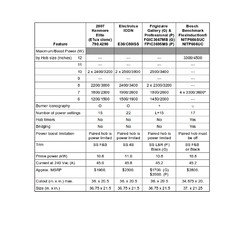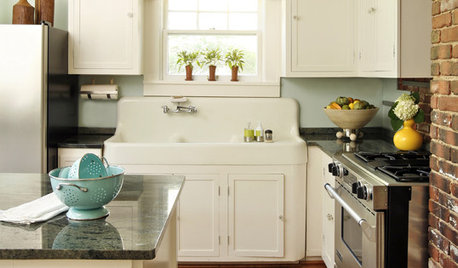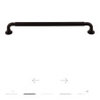Pots Quit Working on New Induction Stove
Hi Everyone,
I've found your posts to be extremely informative when I was doing my homework prior to purchasing my new induction stove three weeks ago. Thank you.
I tested all of my pots' bottoms with a magnet and found that most of them attracted the magnet. I've been using the pots that tested positively for a couple of weeks ago. Suddenly I have a couple of pots that when placed on an induction burner I receive a message from the burner that they are not detected. This is supposed to indicate they are not induction-compatible. The burner shuts itself off and the pot doesn't heat. How could this be? The same pots on the same burners worked for the last two weeks?
To further complicate things, now some pots work on the large flex burner, but not on the round burners that are the proper size for the pot.
I am loathe to have even fewer pots now that are functional. Can anyone help me out with some ideas as to why some of these pots suddenly don't work any more?
Thanks much.
Comments (86)
kaseki
8 years agoThe Electrolux cooktops and their kin have some electronics located below the touch controls in addition to the main boards. This area is not shielded except underneath. In the 2007 era, E'lux had a third stainless steel band separating the controls from the cooking zone to inhibit having a pan base overlap these electronics. The Kenmore clone didn't have this strip.
las
jwvideo
8 years agolast modified: 8 years agoMy smallest saucepan has a 5.25" magnetic base. It worked fine on a
borrowed Cooktek MC2500. A pan with a five inch magnetic base should be no problem on a Cooktek.Beyond that, my
recollection is that 7" figure comes from a troubleshooting chart and is not a minimum pan size requirement from Cooktek. Bear in mind that a 6" or 7" frypan
will flare down to a base that may well be only 4.5" in diameter. (Heck, the cooking surface on my 8" non-stick frypans is only about 5" in diameter which is why I do not have anything smaller). Anyway, the idea of Cooktek's troubleshooting tip is that you to want to sort out pan problems from cooker
problems before you incur the expense of sending your cooker in for
repair.A small pan does not need to be twice as thick as a 7" pan to work on induction. More magnetic mass seems to matter when you get pans with bases less than 4.5" in diameter, but even so, without actually testing them, it can be hard to predict which teeny pans will work and which will not. Weed has something 3.5" in diameter that works. I've read other, similar reports from other Cooktek owners. OTOH, I've read a blog post by a pour-over coffee obsessive whose ultra-elite, tiny, goosenecked-spout Hario teakettle did not work on his Cooktek although apparently the teensy kettle did work on a cheaper Max Burton PIC. I recall a post from somebody on chowhound who had a teensy Vev Vigano espresso pot (about 3.5" diameter) which he got to work on his Cooktek by pacing a 1 quart saucepan of water next to it.
So, you've got a regular saucepan with a 5" diameter base? Should be fine on the Cooktek. You want to use even smaller diameter pans? You may need to experiment to see what works and what does not.
Related Professionals
East Islip Kitchen & Bathroom Designers · Fox Lake Kitchen & Bathroom Designers · Montebello Kitchen & Bathroom Designers · Piedmont Kitchen & Bathroom Designers · Olympia Heights Kitchen & Bathroom Designers · Covington Kitchen & Bathroom Designers · Bloomingdale Kitchen & Bathroom Remodelers · Rochester Kitchen & Bathroom Remodelers · Saint Augustine Kitchen & Bathroom Remodelers · Walnut Creek Kitchen & Bathroom Remodelers · Aspen Hill Cabinets & Cabinetry · Beaumont Cabinets & Cabinetry · Key Biscayne Cabinets & Cabinetry · Livingston Cabinets & Cabinetry · Central Cabinets & CabinetryHU-788641
8 years agoHi, Sincere thanks to everyone for their knowledgeable replies, it looks like I should be able to use the 5". Great forum.
kaseki
8 years agoJw:
I hope your take-away from what I wrote 5 messages up wasn't: "A small pan [needs] to be twice as thick as a 7" pan to work on induction."
I was specifically answering a question by webuser related to magnetic susceptibility equivalence for pan detection using the coil circuit's pulse response. That is, at what rate does the inductive pan base thickness have to increase to keep the response constant as the pan diameter decreases below the coil diameter? Nothing was intended to be implied with respect to a particular circuit's acceptable pulse response detection threshold, which determines how small a normal pan can be and still allow hob operation.
kas
jwvideo
8 years agolast modified: 8 years agoThat was not my take away from your post.
I was only responding to the same question from webuser that you did, i.e., "Is it a reasonable assumption that a 5" pan designed with a layer of
18/0 steel twice as thick as a standard 7" pan would still be detected
by the CookTek and work?"The only implication I drew was that you know more than I do about the technical aspects. :>)
kaseki
8 years agoMy apologies, jw; upon rereading the question and my answer I realized that my answer seems to be agreeing with the conclusion in the question in an awkward manner as if I were somehow disagreeing. I must have misread something.
kas
gigelus2k13
8 years ago@kaseki: I am not sure that the thickness thing is true. The magnetic field will close preferentially through the material with lower reluctance. A piece of iron has a μ in the range of many thousands, while the surrounding air has a μ of *one*. Basically, a sheet of iron 1 millimeter thick will have a reluctance much smaller than a sheet of air 1 meter thick - the entire field will close through that iron sheet.
At the office I have a 7.5" portable Salton hob, the kind Costco carried for a while. I'm using it to heat my 3.5" Turkish coffee pot (ibrik), which is a one piece of glazed steel of maybe 25-27 gauge. The setup works just fine and this small base pot is readily sensed by the $59 hob.kaseki
8 years agoTrue gigelus, and particularly relevant in this case! Thanks for pointing that out to my apparently decaying memory.
This then raises the question of the degree to which the current induced in the iron will create a counter field and at what point the field saturates the iron. I do remember that mu-metal of a given thickness can only shield up to some field strength due to saturation, and stronger fields require thicker shielding. In other words, the B-H curve (as I recall) has some level of B where increasing H is no longer linear in increasing B. Operation in this regime would seem to me to imply a reduction in apparent inductance of the coil, although it is unclear whether more thickness in a smaller diameter would adequately compensate.
Because we know that some small pans on some hobs fail to meet the sensing circuitry's pan detection threshold, we have to question whether field lines are closing while missing the base material, or some other effect causes the apparent inductance to change too much.
And then there is the question of penetration depth of the metal at the operating frequency of the hob. At some point more thickness won't be an aid.
kas
dmaloney24
8 years agoWhat is the distance above the cooktop where it still works? Cast iron griddles on the market have an edge around the bottom - and many have a corrugated bottom shape as well - so much the bottom of the griddle is perhaps a centimeter above the cooktop.
(detail: these griddles are designed to be reversible, meaning the bottom serves as a grill surface when you turn it over. The grill side has a lip around the edge and an undulating surface.)
gigelus2k13
8 years agoA couple of mm spacing will work fine. The mass of ferro-magnetic material will still concentrate the magnetic field and heat up. IMO, the only potential issue is with the pot detection circuit, which may not register the pot presence.
plllog
8 years agoThe problem with the edged griddles is not that they won't heat up, necessarily. They do on mine, though I haven't tried to use one--just tested to see if they would, both a small single and a heavy double with tall ridges. It's that the trapped air underneath can get overheated and be very dangerous, and also can create a situation where the glass will crack. They don't say so because they don't want you to think you can outsmart it, because it's a real issue. Instead, they just say "don't".
The other things I've tried on my Gaggenau are my elliptical Graniteware roaster, with the embossed tree in the bottom and my own Turkish coffee pot. The roaster overhangs the big ring by more than an inch on each side, and is about as wide as the ring in the middle. There are no air traps under the very not flat bottom. It works just fine. Easy to reduce juices. My Turkish coffee pot is open topped, technically "stainless steel" though isn't very strong on the magnet test, and under 4" in diameter. The cooktop detects and heats it, but it puts up such a wail, I mean like the proverbial cat whose tail is caught by the rocking chair, that I would never do it for real (I have the gas for that).
kaseki
8 years agoThis has been addressed here in the past, mainly by noting that the field lines have to go through a quarter-inch (more or less) of glass/Ceram above the induction coil just to get to the closest fitting pot bottom. I cook quite successfully (i.e., DW does) using approximately 1/16-inch silicone pads as spacers. Given a largish device, such as griddles usually are, I would not worry about even another quarter of an inch of gap. Spacing one of those 3.5-inch coffee devices described earlier in this thread off the cooktop by a quarter of an inch, though, might be enough to drop below the detection threshold on some cooktops.
Motivated by this question to conduct a quickie experiment, I just took a squarish, cast-iron griddle pan that was a bit smaller across the diagonal than the sizing cross on my Fridgidaire cooktop's largest hob. Hence, the pan did not cover the entire coil. I put it on two thick stacked hot pads that raised the gap to roughly a half inch. The cooktop did not object upon turn-on and pan heating was evident. I did not try to determine what difference in heating rate might have resulted from such a large gap.
kas
kaseki
8 years agoAlso, to avoid trapped air, a few silicone pads will provide a vent gap and also help reduce conductive heating back into the Ceram.
kas
plllog
8 years agolast modified: 8 years agoGood point, Kas, the kind of silicone hot pad with the deep ridges should fix the problem nicely. I never thought of that. :)
kaseki
8 years agoI use silicone pads cut from smooth silicone sheet sold for cookie baking. I usually use three circular pads in the 1.5- to 3-inch diameter range to establish a three-point contact with air gap.
Note: Historically, the high temperature silicone was loaded with iron oxide and had a matte rust color. However, I don't think this is a requirement for high temperature performance. Other colors are now available if one's decor demands them.
Industrial sources of high temperature sheet are likely the source of the cookie sheet packagers. For an industrial distribution source, see MSCDirect.com. I see at the link below that there is a somewhat pricey 600F black material available; this temperature is way above the vaporization temperature of peanut oil, and should not, except in an accident, ever be damaged by cooking.
http://www.mscdirect.com/browse/tn/Raw-Materials/Rubber-Sheets?searchterm=silicone&navid=4287921519
Various hot pads made of silicone should also work, assuming that they are rated at least to the temperature that the pan base is expected to get to.
kas
dmaloney24
8 years agoVery helpful. I noticed above that some people use a paper towel to protect the ceramic surface. Since paper goes at 450-480F, it's safe to say that such temperatures are not reached; meaning, 600F silicone pads are more than sufficient, and simpler cardboard coasters may do the trick. Since cork goes at 550F or so, a cork coaster should work as well and is thicker than a typical cardboard coaster.
kaseki
8 years agoSilicone pads are easy to clean; paper towels are disposable, cork may not fall into either category, although sheet stock cut into pieces might be relatively disposable. Generally, the pads stay clean except when there are spills.
plllog
8 years agolast modified: 8 years agoThe paper towel isn't to "protect" the surface, really. Just to catch splatters to make clean-up easier. I suppose someone might try to use paper to prevent a gnarly pot from scratching, but better not to use a gnarly pot, which could scratch right through the paper. You have to be even more careful with crystals like salt and sugar if you're using paper because paper shifts and could trap an unseen crystal and scratch with it. Most frying is done under 400° F, so charring the paper isn't an issue.
The Le Creuset silicone hot pads are rated to 482° F. The OXO ones say 600° F, but I think that means that they won't melt if used as potholders, and maybe a slightly lower temperature would be better for continuous use like we're talking about.
If you cut up a cookie mat like Kas, be careful of the interior mesh. Cutting it can release glass fibers. These are thinner than the hot pads (which is why I thought hot pads would be better for raising the griddles, though I'm sure, since Kas is doing it, that there's a sufficient air channel even with the very thin pads.
kaseki
8 years agoThe particular cookie mats I am using are not the reinforced kind, but simple silicone sheet.
To pad a raised griddle, I would use four pads, one per corner. I would use larger diameter pads to take the weight over more of the area of the griddle ridge being supported. Silicone pads of reasonable durometer will not compress much, even with a heavy cast-iron pan, but less stress on the rubber may be beneficial.
kas
plllog
8 years agoOh! Thanks for the further explanation! I've never seen the ones without the mesh. I figured it was the case about the compression not being an issue since you recommended it. :)
User
8 years agoWoo some answers here, way beyond my understand all I want is some advice, do or need a service call or is everything OK
So here's where I'm at. I bought a Neff T40B31X2GB 59cm four zone induction hob a few months back. I have a Judge teapot with a 4 inch base and it is described as '18/10 Stainless Steel with a thick Thermic base suitable for all hob types'
If I place it on the back left zone of the Neff it won't work, if I place it on any of the other three zones it will work, if I place a cheap 5 1/2 inch saucepan on it then it works. So I'm wondering if I have a faulty zone or is it just that the teapot is to small for that particular zone? I have tried turning the power completely off at the meter, but that makes no difference
I don't quite understand this but do all zones on induction hobs produce the same energy ie should say 2 pints of water boil just as quickly on all the zones, or are some less powerful than others? Are all zones the same size width wise?
Should it be a faulty zone I suppose now would be the time to get a call out
kaseki
8 years agolast modified: 8 years ago18/10 stainless steel is non-magnetic, but there may be some other steel in the base that allows operation. Four inches is on the small side, but still adequate for many smaller sized hobs.
Hobs have power capabilities that are established by the design. They can be all different, all the same, or mixed in some way. It is also possible to make a hob to have different zones, although none of the cooktop units that I have owned are of that configuration.
A selected example of hob power variations may be found in this table I previously included in a topic thread.
Click on the table for a readable size.
ElleServices
7 years agoJust had this happen to me which is why I came here. However, it was not my induction cooktop so I want to share. If you happen to store your good/working just fine pan where it can have its polarity altered it will not attract magnets any more. I hastily put frypan in the oven ON the resistance which was off and my nice new pan no longer holds a magnet. So #1 careful where you put your induction compatible pans and #2 test a pan that's not working with a magnet before you start worrying about your induction cooktop!
kaseki
7 years agoI'm sorry, but experimental result makes no sense to me. If the oven heater was truly off and stayed off, then there should have been no effect on the stainless steel metallurgy that determines magnetic permeability. There is no polarity involved. The induction cooktop uses alternating polarity fields at high frequency to induce alternating currents in the steel base. These heat the steel and hence the pan contents. Stainless steels used for induction ready pots and pans should be stabilized ferritic metallurgy and difficult to affect even if over heated.
It is possible that a normally non-magnetizable stainless steel is work hardened in a manner that makes it somewhat magnetizable such that it might heat on an induction coil, and if annealed by enough heat would lose that property. This shouldn't be the case for induction ready cookware, and in any case would require that the oven be turned on.
kas
ElleServices
7 years agoIt is possible that a very small current is passing through the resistance - it has never worked although the red light comes on. The oven does not heat.- never has. The induction ready pan worked fine until I inadvertently stashed it in the oven directly onto the electric coil/resistance which I thought was off since it doesn't heat. Before that, a magnet would stick and it worked fine. Now the magnet doesn't stick, the cooktop "rejects" it (EU) and of course it doesn't heat ...but its twin bought at the same time but stored elsewhere works just fine. One seems demagnetized while its twin is still working just fine and of course passes the magnet test. I am simply reporting this set of facts in the event it should help someone,
kaseki
7 years agoElleServices: Thank you for your input. All discoveries, particularly the unexpected, are useful.
It is important in these cases to try to chase down the actual cause. Pans are not normally magnetized. The external magnet used to test them is magnetized, and just as it would stick to a soft iron not-magnetized nail, it will stick to cooking ware steels that are designed to be ferritic in their metallurgy and capable of efficient use with induction. Normal use of these pans will not lead to demagnetization (because they aren't magnetized except when in an electromagnetic field) or loss of their ferritic microstructure.
Further, if the oven is hooked up to normal household power in most parts of the world, would have alternating current passing through it heating coils. From the information so far, I can only guess that the pan wasn't ferittic steel, had some slight magnetizability (perhaps a martensitic steel) and its crystalline structure was somehow converted in the oven. This is quite a stretch for me, but I would like to chase this down.
An alternative theory is that someone made pans that are not ferritic steel, but included some steel that had been magnetized and was recognized by the induction cooktop as valid. An AC field from the oven coil could conceivably demagnetize it, but this would require significant current, not just leakage current.
Quite a mystery. Is this defective oven in a commercial establishment where the oven and the pan are not under your 24/7 control?
Please let us know the pan's brand and model.
kas
ElleServices
7 years agoThe twin skillets/ pans were a gift from a friend last year. There are no markings on them anywhere- not even "Made in ..."
kaseki
7 years agoMust be AlienWare. :) [sorry] I think I'm at a dead end in guessing cause. I also think you would not observe the same loss in functionality with quality pans.
Existential observation: Sometimes one has a friend or relative who believes that it is the thought (and only the thought) that counts. One just has to grin, accept the gift, and find some space for it.
kas
ElleServices
7 years agoYes, but I have since given the faulty one away and am careful where I store the one that still works. So glad it is not the cooktop!
plllog
7 years agoI have an AlienWare Turkish coffeepot. It's theoretically stainless. My Gaggenau cooktop turns on for it, even though it's only 4" in diameter. Then the screaming starts. There are some things you can use on induction, but probably shouldn't. :) I don't make Turkish coffee anymore, but if I had occasion, I'd use my gas. :)
kheflw
7 years agoIt's really amazing the difference, quality, speed of induction capable pots. We spent a couple hundred on some Calphalon cookware to start out. Yeah it works just fine, but over time I noticed that you dont get a fast/high boil of water on certain burners, a little higher on others. Then we were at a garage sale about a year ago, a guy was unloading a brand new box of Kenmore Elite pots and pans. $30 I think. Deal of the day! I can get a faster boil with these, same size pot, same burner, on a setting of 7 than I do with the Calphalon on 9. Instant reactions from the Kenmore pots as well. Calphalon are non-stick. Kenmore are just stainless. Having the right pot for the job is important.
Having my pot reverse polarity in the oven, that would freak me out. I only put Cast Iron in the oven though.
User
7 years agoI have a True Induction dual burner, inset stove top which has been working for over a year with no problems. However, today the right burner only turned on to temperature then immediately off, and then just keeps turning on and off, on and off. It doesn't matter if I select temperature or heat, it won't stay on. It's as though it doesn't think there is a pan there. I have cast iron, plus a couple of pans specifically for induction cooking and no go on any of them. Thing is my pans have worked in the past -and continue to work just fine on the other burner which also works, no problem. Anyone have any ideas?
mbdown
Original Author7 years agoHi there. I think I am the person who began this topic here. Your description sounds similar to something that began happening to me about a month ago. We found that if we turned off the breaker for the stove in the main electrical panel box and waited a minute or two, then turned it back on again, the stove returned to normal function. Hope this helps.cluedin
7 years agoI've been thinking about getting an induction range. This discussion is an eye opener to the new problems that are possible with new technology. Of course induction boils water much faster than gas ( which is very slow and inefficient), but it doesn't make a huge change from electric ceramic. I use cast iron on my ceramic cooktop with great success. The cast iron, once heated is a perfect medium for even heat and searing of meats and veggies. In fact, i wonder how much of the improvement in cooking on induction is attributable to the better quality cookware that is being used, especially cast iron. So i'm still considering the new induction technology, but worried about servicing problems.
sjhockeyfan325
7 years agoi wonder how much of the improvement in cooking on induction is attributable to the better quality cookware
I'm really not sure what you're getting at - I have an induction cooktop (previously always had gas, and had a regular electric in a summer rental) and don't use high-end cookware. For pots, I use Tramontina that I got at Walmart and one small pot from IKEA. For pans, I use Lodge cast iron, a couple of Kitchen Essentials from Calphalon that I got at Target, and a ceramic pan under the Zwilling name. No All Clad, or Demeyre or others for me. And I would never willingly return to another "fuel" source. I'm also not sure what you mean by "it doesn't make a huge change from electric ceramic". It's a HUGE difference in heat generated, safety, cleaning, cooking control.
gigelus2k13
7 years agolast modified: 7 years ago@cluedin: have you cooked with induction before? because your comment about induction being almost on par with standard electric hobs is so wrong that it suggests you have not. Induction is significantly better than plain electric in terms of energy efficiency, wasted heat and response time to settings changes.
It appears that the drawback is lower reliability than either gas or plain electric because the electronics that sense the pot get decalibrated or just quit working. However, when it works, induction is close to magic.
writersblock (9b/10a)
7 years agonew problems that are possible with new technology
True, but induction cooktops have been around since the 1970s, so induction itself is not new, just new to many people in the US.
gigelus2k13
7 years agowhat's new is the race to the bottom in terms of price, which invariably drags the quality down. More eye candy that's cheap to make but worse baseline build quality.
kaseki
7 years agoAs I noted in other threads, for induction cooktops I believe a warranty extension is cost effective due to the high cost of board repair after the typical first year warranty period is over. With a five year warranty, the effective yearly lease cost of the cooktop is the price divided by 5. And unlike a car lease, one can keep the product without further payment after five years until it fails. In the case of the lower priced Kenmore and Frigidaire units, the cost of a power supply board and a generator board (they may fail together) plus labor is only a little less than the price of a new cooktop.
I have no information on cost or availability of a further warranty extension beyond five years, but if available, buying the extension would still be cost effective in my view.
In any case, I consider induction to be so superior for my purposes to the alternatives that I am willing to accept the implied greater cost due to potentially limited lifetime, not that limited lifetime is only applicable to induction cooktops.
With respect to the topic earlier in this thread about pan susceptibility loss after storage in a non operating oven, it has occurred to me that there was a third possibility not covered in my previous comments: If the pan were marginal in induction response due to wrong metallurgy for induction, and the pan were heated enough to change its metallurgy before going into the oven, then its failure to be detected as acceptable to the hob when removed from the oven may have nothing to do with the oven storage itself but instead to the pan's past thermal history.
kas
venmar
7 years agoKas, since I have not had a smile of the day yet, I want to ask if your above comment in any way alludes to "Hot Flashes", sorry, I had to! The coffee is just starting to kick in. I think ths.gardenweb threads are better with a little humour, juvenile or not along with the valid information and help.
kaseki
7 years agoI failed to notice a 'hot flashes' opportunity in my previous prose. I fear that as a punster I am at best a flash in the pan.
debbie2340
7 years agolast modified: 7 years agoMy son has a Samsung induction range. His cheaper pots worked on the hobs. He wanted a good set and purchased a set of Demyere which is made for induction. The large fry pan would not work on the large hob. However if he put it off center than brought it back center it would work. He called Samsung and they replaced cook top and than two were not working. They are now going to replace range. Do you think this was a problem with hobs or cookware? He should get new one in a week. I dont understand why they did not work with the new cooktop. Oh and they do work on the other smaller hobs. Dont understand this at all. Any help appreciated.
kaseki
7 years agoDebbie2340: I think that to understand this at any deep level would require knowing the details of Samsung's pan-sensing circuitry. Sometimes more is less when non-linear circuit behavior is in play, whether deliberate or accidental. Magnetic circuits can often demonstrate non-linear behavior. It is possible that when aligned with the hob coil the Demyere large pan
is a better induction target than the circuit designer expected. For example, the pan may damp the coil circuit resonance faster than any pans used in testing by the designer.The intent of ISO9001 is consistency. If Samsung's production is ISO9001 certified, a new range would be expected behave the same as a new cooktop, assuming the cooktop "smarts" are part of the cooktop. But production defects still occur. Only Samsung will know if the two cooktops tried so far are part of a defective production lot that they can locally avoid using a new range with a different lot's cooktop.
kheflw
7 years agoHe should get a cast iron pan to test out the cooktop. The pots react SO different. Dont know anything about Demyere, but I have two sets, one works good the other doesn't. I keep them only for things where you just Have to use Non-Stick.
Jo
7 years agoI have a Demeyere frying pan, never had any issues with it on induction - mine is Miele.
alex1885
7 years agoI have a problem very similar to Debbie2340. I recently purchased a top of the line Samsung Induction Slide-In Range. It contains 1 large induction cooking zone and 2 smaller cooking zones. To pair my high-end range, of course I couldn't resist to purchase high-end cookware. I purchased the all-clad nonstick set which should work with induction cooktops. All of the all-clad pieces work on the smaller zones. However, none (not even the large pans) work on the large zone. The error code says that pan is not detected. The manual contains minimum pan base diameter specifications, which says the base must be at least 7 1/4 inches in diameter. My all-clad set has 3 large pans which have exactly 7 1/4 inches of magnetic base diameter (these don't get detected). After much experimenting, I discovered that if I place the pan 2 or 3 inches beyond the circle (to the front or the the right), it then gets detected and then I am able to slide the pan back into the circle and it will continue to heat. Even with this silly workaround, I had to call Samsung and they sent a service technician who replaced several parts and the mainboard. This did not help solve the problem. I then had the entire range replaced with a brand new one. Unfortunately, the new one has the exact same problem and symptoms. I then called Samsung and had a long discussion with the service rep (who was very understanding and sympathy and tried getting an expert engineer to assist). When I was describing the characteristic of the base of the all-clad large pans, I explained that full length of the base is actually near 8 1/4 inches in diameter. The base seems to have very small outer ring (1/2 inch) and this outer ring is not magnetic. The inner ring is exactly 7 1/4 inches in diameter and it is magnetic. I used the magnetic strip provided with the range to test which part of the base is and is not magnetic. Keep in mind that both the inner and outer rings of the pan base I mention above are flat and leveled to each other and connected. The only way to distinguish them is the color. The outer ring is more silverfish in color. The Samsung engineer believes that the non-magnetic outer portion of the pan base is causing the sensors to display that the pan is not detected. In other words, they believe that it detects that there is a nonmagnetic material in the cooking zone and thus will not activate. By moving the pan several inches beyond the circles fools the detection logic since the non-magnetic portion of the pan is no longer inside the cooking zone. This is their theory. I then acquired a cheaper pan from Kitchen Aid (10" skillet with a 7 1/4 inch base diameter). The kitchen aid pan works perfectly on all the cooking zones, including the large cooking zone. The kitchen aid pan has a base which is 100% induction capable (magnetic end to end). So even though both my All-Clad and Kitchen Aid pans have 7 1/4 inches of magnetic material diameter, the All-Clad has extra non-magnetic material on the outer section of the base (1/2 inches on each side, thus a total of 1 inch diameter). At this point I am very disappointed at both Samsung and All-Clad. Samsung seems to have very strict (or hidden) detection requirements which are not clearly communicated to the public. All-Clad should have known this and avoided making expensive induction cookware which has a small non-magnetic section on the outer section of the base. I cannot return the All-Clad cookware since I've already used most of the pans. I will reach out to the All-Clad customer service to get their thoughts on this situation.
Bottom Line, Samsung will likely claim that the cookware is the problem. All-Clad will likely claim that Samsung's cooktop is the problem.
Does anyone on this forum have any thoughts/comments/suggestions?
I can post a photo of the base if anyone thinks it would be helpful.
Thanks, Alex1885
kaseki
7 years agolast modified: 7 years agoVery interesting. Perhaps this outer ring is aluminum. As I recall, aluminum is paramagnetic, and induced currents create a reversed polarity magnetic field relative to a ferromagnetic reaction field (or something like that -- I'm trolling a very old memory*). So, if the induction field of the cooktop produces a normal reaction from the inner steel pan base and a cancelling reaction from the outer ring, the net induction effect on the sensing circuit may be a reaction that is marginally too weak.
When the pan is displaced from circular alignment, some of the aluminum moves outside the induction field, and some moves closer to the hob center (where the field is weaker) and now perhaps the ferromagnetic reaction is relatively stronger than the paramagnetic reaction. I'm not sure that a ring-down rate induction sensing circuit scheme would care about non-magnetic portions of the base, so long as the magnetic portion's reaction field was large enough and not being cancelled out.
kas
------
* I recall a college lab experiment where we floated an aluminum cup above an induction field. In this case the generating field was pushing against the reaction field and the fields, although alternating, were effectively acting like a pair of horseshoe magnets pushing against one another due to aligning north pole to north pole and south pole to south pole.
Brian Chapman
6 years agoHad problems over 4 years with Neff similar problems. Acquired some Cooks Essentials pans from QVC UK that worked anywhere but non stick getting scratched and damaged by steel potato masher. QVC did get a milk stainless steel pan with copper coloured non stick last year and this really really exelent but QVC now only appeared to have a frying pan similar. Now tried on 3 occasions to buy replacements elsewhere but all 3 have gone back as nor working anywhere or only on this or that ring.
Now considering to buy some old fashioned vitreous enameled carbon steel pans that won't have flat flat bottoms but difficult to find.
Any suggestions? UK


















herring_maven